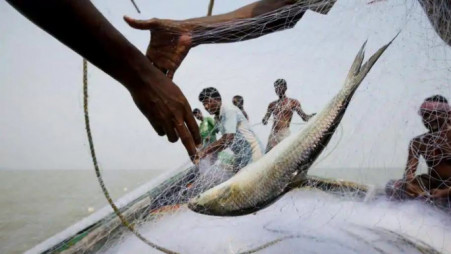Hilsa prices jump up to 52% as exports plunge to 7-year low
Ahead of Durga Puja, prices climbed further by Tk200–400 per kg due to high demand, just before the government imposed a ban on catching, transporting, marketing, and storing hilsa on 4 October to protect mother hilsa during the peak breeding season

Highlights:
- Hilsa prices rose 28–52% year-on-year across all sizes
- Government imposed a hilsa fishing ban from Oct 4–25
- Exports to India dropped to a seven-year low of 145 tonnes
- Declining catches and high costs worsened supply shortages
- Middlemen and hoarding practices inflated consumer prices sharply
- Environmental damage and river changes reduced hilsa breeding migration
Hilsa prices in Bangladesh have surged sharply this year, rising by Tk200–1,000 per kg compared to last year, depending on size.
Ahead of Durga Puja, prices climbed further by Tk200–400 per kg due to high demand, just before the government imposed a ban on catching, transporting, marketing, and storing hilsa on 4 October to protect mother hilsa during the peak breeding season. The ban will remain in effect until 25 October.
Visits to Dhaka markets in Shahjadpur, Uttar Badda, Mohakhali, and Karwan Bazar in the two weeks before the ban showed 1–1.25kg hilsa priced at Tk2,200–2,500 per kg, 700–900g at Tk1,800–2,000 per kg, 500–600g at Tk1,400–1,700 per kg, 200–450g at Tk900–1,200 per kg, and smaller jatka at Tk600–800 per kg.
According to the Department of Agricultural Marketing and Dhaka kitchen market data, hilsa over 1.5kg costs Tk1,800–2,000 per kg in August last year, while this year the same size is priced at Tk2,800–3,000 per kg.
Compared to last year, retail prices increased by Tk800–900 per kg for 1–1.5kg hilsa, Tk300–350 for 750g–1kg, Tk400 for 500–750g, and Tk200–250 for smaller hilsa—marking a 28–52% rise in just one year.

Exports plummet to lowest in seven years
High domestic prices have sharply affected hilsa exports. Although 1,200 tonnes were approved for export to India for Durga Puja, only 145 tonnes were shipped, the lowest in seven years.
Data from the Department of Fisheries and the National Board of Revenue show that hilsa exports over the past decade effectively began in the 2019–20 fiscal year. The highest export in the last seven years was 1,699 tonnes in 2020–21, while the previous lowest was 476 tonnes in 2019–20.
The Ministry of Fisheries and Livestock reported that 106 tonnes were exported via Benapole port and 39 tonnes via Akhaura port. Thirty-seven companies were approved for hilsa export, including Pacific Sea Foods in Kalurghat, Chattogram, which was allowed to export 40,000kg but shipped only 1,560kg.
Abdul Mannan, the company's director, said, "High local prices and low supply reduced exports, while cheaper Myanmar hilsa outsold Bangladeshi hilsa in the Indian market."
Stakeholders noted that this year's supply has been far below demand. Advance loans, high middleman profits, and stockpiling further pushed retail prices unusually high.
Fishermen and traders reported that large hilsa have largely not appeared in the sea or rivers, leaving mostly smaller fish in the market, which contributed to soaring prices.
Mannan Rana, a fish trader at Char Chenga Bazar in Hatiya, Noakhali, said, "Sending a trawler to the sea costs Tk3.5–4 lakh, including fuel and labour, but this year the catch has been poor, mostly small hilsa, with very few large fish, contributing to high market prices."

Declining catch, rising costs
Fisheries and Livestock Adviser Farida Akhter said at a press conference that hilsa catches have declined about 10% over the past five years. In July and August this year, catches fell 33% and 47% respectively compared to the same months last year.
After catching hilsa, fishermen usually take trawlers to river ghats, where commission agents who provide advance loans collect fish from fishermen and sell it to wholesalers through auctions.
Wholesalers then transport the fish to Dhaka and other areas for retail. Hilsa often changes hands four to six times before reaching consumers. A study by the Bangladesh Trade and Tariff Commission found that with each handover, the price rises by nearly 60%, meaning fishermen receive less while consumers pay more.
The commission identified several reasons for the price increase, including an imbalance between supply and demand, hoarding, syndicates, rising fuel and transport costs, higher fishing expenses, navigability and environmental problems in rivers, illegal nets, advance loan practices, lack of alternative jobs, fishing during the ban, exploitation by middlemen, and export pressures.
Their report shows it costs fishermen around Tk471–504 per kg to catch hilsa and bring it to the wholesale market, yet consumers end up paying Tk700–3,000 per kg depending on size.
SM Nazer Hossain, vice president of the Consumers Association of Bangladesh, said, "Fish traders are using supply shortages to hike hilsa prices in the absence of government monitoring. Prices rise drastically by the time hilsa reaches consumers, generating excessive profits."

Environmental, navigational challenges
Navigational problems, shoals, encroachment, pollution, climate change, and infrastructure such as dams and bridges are also making it harder for hilsa to migrate into rivers. Catching hilsa from the sea has become more expensive due to high fuel and other costs, pushing prices further.
Hilsa researchers explained that during the monsoon season, the lower Meghna River's water becomes clearer and less salty, with strong currents pulling hilsa from the sea into rivers for spawning. Reduced rainfall and changes in river flow have lowered water levels and raised temperatures, reducing hilsa presence.
Md Anisur Rahman, former chief scientific officer at the Fish Research Institute in Chandpur, said, "Hilsa are deep-water fish. Shoals can force them back to the sea. Sand extraction, pollution, uncontrolled construction in rivers or estuaries, and factory pollution are disrupting the environment needed for hilsa production."
TBS Jashore correspondent contributed to this report



 Keep updated, follow The Business Standard's Google news channel
Keep updated, follow The Business Standard's Google news channel
















